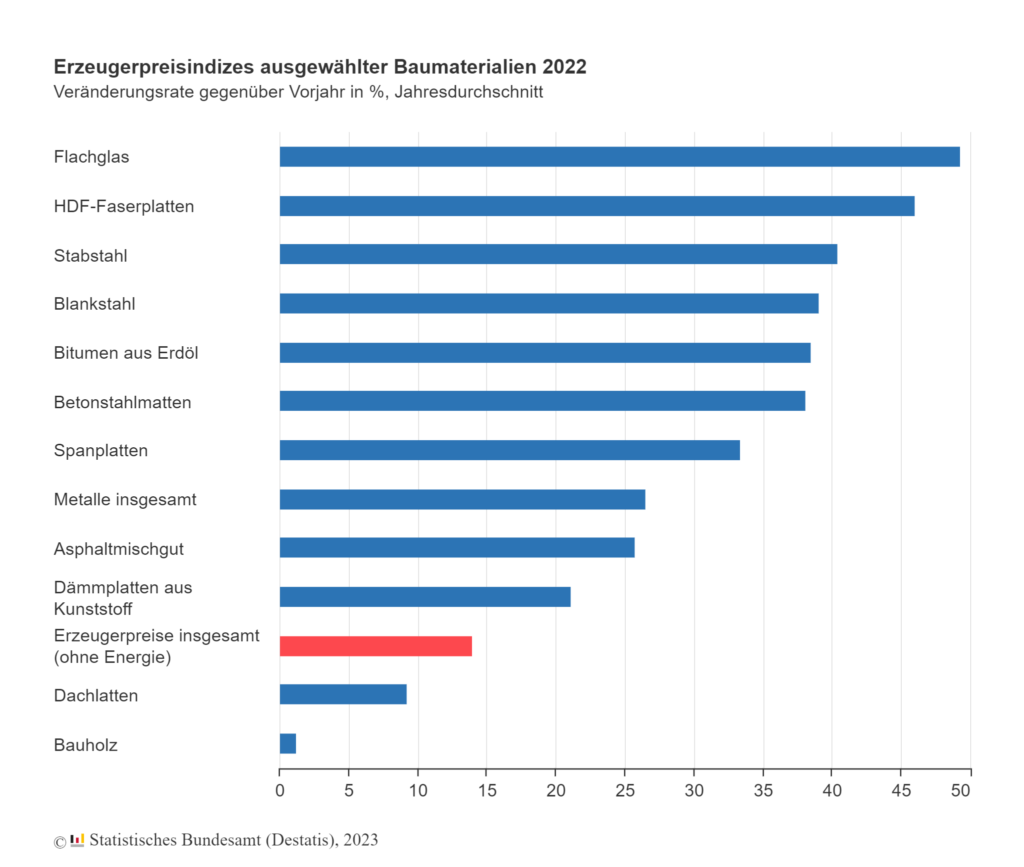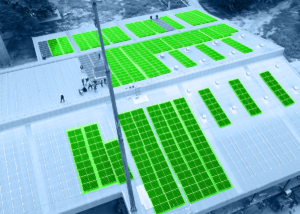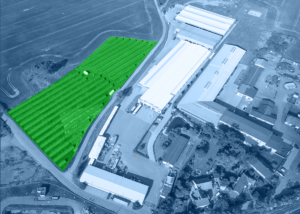Solar/photovoltaics: Residential construction market crisis – Does the slump in building permits have an impact on the photovoltaics industry?
Language selection 📢
Published on: June 20, 2023 / update from: June 20, 2023 - Author: Konrad Wolfenstein

Does the slump in building permits in the residential construction market have an impact on the photovoltaics industry? – Image: Xpert.Digital / moreimages|Shutterstock.com
Does the slump in building permits in the residential construction market have an impact on the photovoltaics industry?
The collapse of the housing market has the potential to impact the photovoltaic industry, although the exact extent and nature of the impact may depend on various factors. Here are some possible influences:
Demand for solar energy
If the housing market collapses, this could lead to a decline in demand for newly built homes. Since the installation of solar energy systems often accompanies new construction or renovations, a decrease in construction activity could also lead to lower demand for photovoltaic installations.
Decline in installation orders
If fewer residential buildings are built or renovated, this may lead to a decline in orders for solar installers. Companies in the photovoltaics industry could face lower demand and more intense competition for available orders.
Price war and margin pressure
A decline in demand may lead to increased competition among solar companies. This could lead to a price war and increase pressure on margins. Companies may be forced to lower their prices to remain competitive, which could affect their profitability.
However, it is important to note that the photovoltaic industry is influenced by many other factors such as: B. government incentives, environmental regulations, technological advances and the growing awareness of renewable energy. These factors can mitigate or compensate for the impact of the housing construction market slump on the industry. More stable growth in other sectors, such as B. commercial or industrial solar energy could also help offset potential losses.
Influence can be seen in the area of single-family and multi-family homes
➡️ Decline of 27.3%: Approved apartments from January to April 2023 significantly lower than last year
➡️ Sharp declines in building permits for new buildings from January to April 2023:
- Single-family homes (-33.5%)
- Two-family houses (-52.1%)
- Apartment buildings (-27.1%)
A short survey we recently conducted among solar installers shows that demand for solar systems for single- and multi-family homes is stagnating and that customers' purchasing behavior is cautious. Many potential customers are postponing offers that have already been made to a later date, which will lead to increased price pressure and intensified competition in the industry.
The slump in building permits in the residential construction market has a direct impact on solar installers, as the installation of solar systems often goes hand in hand with new buildings or renovations. The fact that demand for single- and multi-family homes is stagnating has a direct impact on solar installers' installation orders and sales.
Customers' reluctance to purchase solar systems can be due to various factors. The uncertain economic situation and reduced construction activity could lead to a lower willingness to invest. Additionally, cost savings in new home construction could result in solar systems being viewed as optional features and neglected by builders and buyers.
The situation has already led to increased price pressure and intensified competition among solar installers. To remain competitive, some companies are forced to lower their prices, which can hurt margins. Competition for available jobs is fierce, leading to an oversupply of installers in the market.
Solar engineers are required to adapt their strategies and find innovative approaches to meet the current challenges. This may include increased customer outreach, the development of tailored offerings and diversification of operations towards other market segments such as commercial and industrial facilities.
Overall, the solar/photovoltaic industry remains dependent on developments in the residential construction market. A recovery in housing construction and increasing demand for solar installations could help overcome current difficulties and ensure the long-term growth of the industry.
➡️ Nevertheless, it is important to look at the dynamics of the photovoltaics industry as a whole and not just focus on the housing market collapse in order to get a more comprehensive assessment of the impact on you personally.
According to the media, the solar industry is booming, but the residential construction market is collapsing. How is that possible?
The apparent contradiction between the boom in the solar industry and the collapse in the residential construction market may have various reasons. Here are some possible explanations:
Different market dynamics
The solar industry and the residential construction market are two separate industries with different market dynamics. While the residential construction market depends heavily on factors such as supply and demand, construction costs and financing conditions, the solar industry is driven by factors such as government support programs, environmental awareness and the expansion of renewable energies. It is therefore possible that the solar industry will benefit from positive developments in its specific sector, while the residential construction market will suffer from other challenges.
Shift in demand
It could be that consumer demand has shifted from traditional residential real estate to investing in renewable energy such as solar. Increased environmental awareness and demand for sustainable solutions could help the solar industry become more prosperous than the residential construction market.
Regulatory framework conditions
Different political and regulatory frameworks may impact the two markets differently. It is possible that government support and incentives for renewable energy development have increased demand for solar energy, while at the same time restrictions or changes in building regulations are affecting the residential construction market.
Long term perspective
The collapse of the housing market may be a temporary phenomenon due to short-term factors such as economic uncertainty, increasing costs of building materials or changes in real estate demand. The solar industry, on the other hand, could have long-term growth potential as the transition to renewable energy and sustainability plays an increasingly important role.
➡️ It is important to note that these statements represent general factors and the exact situation may vary from country to country. It's a good idea to look at specific data and analysis to get a comprehensive picture of the relationship between the solar industry and the residential construction market in a particular region.
Significant decline in building permits for apartments in April 2023 compared to the previous year by 31.9%
In April 2023, a total of 21,200 apartments were approved in Germany, as reported by the Federal Statistical Office (Destatis). This corresponds to a decrease of 31.9% or 9,900 building permits compared to April 2022. This means that Germany once again recorded the largest year-on-year decline since March 2007 (-46.5% compared to March 2006). As early as March 2023, the number of building permits for apartments had fallen by 29.6% compared to March 2022. Since May 2022, the number of newly approved apartments has always been lower than in the same month of the previous year, and since January 2023 the decline has been more than 20%.
A total of 89,900 building permits for apartments were issued from January to April 2023, which corresponds to a decrease of 27.3% compared to the same period last year (January to April 2022: 123,700 building permits). This decline is largely due to high costs of construction materials and increasingly poor financing conditions. The impact of these factors on housing construction is noticeable and is leading to a decline in construction activity.
The results relate to both building permits for apartments in new buildings and new apartments in existing buildings. From January to April 2023, a total of 74,900 apartments were approved in newly built residential buildings. This corresponds to a decrease of 30.3% or 32,600 apartments compared to the same period last year. The number of building permits for single-family homes fell by a good third (-33.5% or -9,200 apartments) to 18,300. There was a decline of more than half (-52.1% or -5,800) in two-family houses to 5,300 approved apartments. Even in multi-family homes, the most common type of building, the number of approved apartments fell by more than a quarter (-27.1% or -17,900) to 48,200.
These figures illustrate the current challenge in housing construction and the declining trend in construction activity. The ongoing difficulties with the costs of building materials and financing conditions are having a negative impact on the construction of new housing. It is crucial that appropriate measures are taken to stimulate housing construction, promote investment and improve the framework conditions for construction projects.
Plan your solar system for the most common applications conveniently online with our solar system planner!
With our user-friendly solar system planner you can plan your individual solar system online. Whether you need a solar system for your home, your business or for agricultural purposes, our planner offers you the opportunity to take your specific requirements into account and develop a tailor-made solution.
The planning process is simple and intuitive. You simply enter relevant information. Our planner takes this information into account and creates a tailor-made solar system that meets your needs. You can try out different options and configurations to find the optimal solar system for your application.
Additionally, you can save your plan to review later or share with others. Our customer service team is also available to answer your questions and provide support to ensure your solar system is optimally planned.
Use our solar system planner to plan your individual solar system for the most common applications and advance the transition to clean energy. Start now and take an important step towards sustainability and energy independence!

The solar system planner for the most common applications: Plan the solar system online here - Image: Xpert.Digital
More about it here:
Collapse in building permits for apartments (2022/2023)
The Federal Statistical Office (Destatis) has recorded a worrying decline in building permits for apartments in newly built residential buildings. From January to April 2023, a total of 74,900 building permits were issued, a decrease of 30.3 percent compared to the previous year. For single-family homes in particular, the number of building permits fell by 33.5 percent to 18,300 apartments. Two-family houses even fell by more than half (-52.1 percent or -5,800 apartments) to 5,300 apartments. Multi-family homes were also affected by a significant decline, with a decrease of 27.1 percent (-17,900 apartments) to 48,200 approved apartments.
This decline in building permits is expected to further worsen the housing shortage in Germany. The government target of 400,000 completed apartments per year is already being clearly missed. This particularly affects people with low incomes and renters in large cities. According to Destatis, an average of 27.8 percent of income in Germany has to be spent on rent, while in cities with 100,000 or more inhabitants it is even 28.9 percent. Households with a monthly net household income of 1,500 euros or less are particularly heavily burdened because they have to spend over 40 percent of their income on rental costs.
This development raises the urgent question of measures to promote affordable housing. In order to meet the growing demand, investments in housing construction, especially in social housing, are of great importance. Creating incentives for private investors and collaboration between the government, the construction industry and other relevant stakeholders are needed to address the housing shortage and ensure that adequate and affordable housing is available for all population groups.
Rising energy prices lead to price increases for steel, glass, bitumen and plastics
The impact of the coronavirus pandemic and the war in Ukraine has led to significant challenges in the construction sector, including supply bottlenecks, material shortages and increased energy prices. According to the Federal Statistical Office (Destatis), almost all building materials were again significantly more expensive on average in 2022 than in the previous year, when high price increases were already recorded.
The increased energy prices, which had an impact on various energy-intensive building materials, were particularly impactful on the construction sites. On average for 2022, prices for bar steel rose by 40.4%, for bright steel by 39.1%, for reinforcing steel mesh by 38.1% and for steel pipes by 32.2% compared to the previous year. Steel is often used in conjunction with concrete in shell construction to reinforce floor slabs, ceilings or walls. Metals as a whole rose in price by 26.5% in 2022 compared to the previous year.
The price of flat glass, which is commonly used for windows, glass doors or walls, also increased by 49.3% on average in 2022 compared to the previous year. For comparison: The producer price index for commercial products as a whole rose by 32.9% on average in 2022 compared to 2021. Without taking energy prices into account, producer prices were 14.0% higher than the annual average in 2021.
These price increases have a significant impact on construction costs and represent an additional burden on the construction industry. They can affect the profitability of construction projects and lead to higher costs for builders. Given the ongoing challenges in the construction sector, it is important to explore alternative sourcing routes, diversify supply chains and consider sustainable material solutions to minimize the impact on the construction industry.
Price increases for petroleum-based building materials
In 2022, construction materials saw significant price increases, particularly petroleum-based products. Bitumen, an important building material in road construction and for sealing buildings, increased in price by 38.5% on average for the year compared to 2021. Asphalt mix, which also contains bitumen, recorded a price increase of 25.8% compared to the previous year.
The overall high energy prices also had an impact on chemical products that are widely used in the construction sector. Producer prices for insulation panels made of plastic such as polystyrene rose by 21.1% compared to the previous year. Epoxy resin, an important binding agent for paints and varnishes, rose in price by 15.1%. Paints and varnishes based on epoxy resins cost an average of 24.0% more.
Prices for wood building materials developed inconsistently. HDF fiberboard, chipboard and wooden window and door frames recorded significant annual average price increases of 46.0%, 33.4% and 24.4%, respectively, in 2022 compared to the previous year. However, the prices for lumber and roof battens rose below average by 1.3% and 9.3%, respectively, in the same period. The prices for solid structural timber even fell by 11.9%. In 2021 there were particularly strong price increases for solid structural timber, roof battens and construction timber.
In addition, the increase in the price of diesel fuel is also hitting the construction industry significantly. On average, producer prices for diesel fuel rose by 41.6% in 2022 compared to the previous year. Diesel fuel is required to operate construction machinery and in transportation.
The increased prices for building materials and fuel represent a major challenge for the construction industry. Companies have to deal with higher costs and more intense competition for orders. This can impact construction activities, investment decisions and ultimately the cost of construction projects. Careful planning, efficient use of resources and finding alternative materials or solutions can help mitigate the impact of price increases.
The price increases for building materials also have an impact on the costs of construction work
In 2022, prices for new residential buildings rose on average by 16.4% compared to the previous year. This change represents the highest increase since data collection began in 1958. Almost all areas recorded significant price increases. The costs for insulation and fire protection work on technical systems rose by 27.2% compared to the annual average for 2021. Glazing work was 21.2% more expensive than in the previous year, metal construction work was 20.7% more expensive and steel construction work was 19.8% more expensive.
There are several reasons for this significant increase in construction costs. On the one hand, the increased prices for building materials such as steel, glass and insulation materials play a role. The increasing global demand for these materials, limited production capacities and supply bottlenecks have led to price increases in the market. In addition, labor costs have also increased, which has contributed to further price increases for construction work.
The effects of these price increases on the construction and real estate sector are diverse. Construction companies are faced with the challenge of managing rising costs while remaining competitive. For private builders, the higher costs can make building homes or renovation projects more financially burdensome. Overall, the creation of affordable housing is becoming even more difficult as construction costs increase.
The development of construction prices and building materials is an important indicator of the economic situation and can have an impact on the entire construction sector. It is therefore crucial that governments, construction companies and other stakeholders take appropriate measures to control the increase in construction costs and find sustainable solutions. This may include, but is not limited to, encouraging innovation, investing in infrastructure and improving efficiency in the construction industry.
Rising energy prices and price increases for petroleum-based building materials = fewer building applications or building permits
The rising prices are having a noticeable impact on housing construction in Germany. In the period from January to November 2022, the number of building permits for new residential and non-residential buildings fell by 5.7% to around 322,000 permits compared to the same period last year. For new residential buildings to be built, around 276,000 apartments were approved from January to November 2022, which corresponds to a decrease of 5.8% compared to the same period last year. In particular, the number of building permits for single-family homes fell by 15.9%, while there was a decline of 10.1% for two-family homes. In contrast, a slight increase of 1.2% was recorded for multi-family homes. There was also a decline in existing residential buildings: around 38,000 construction projects were approved in the period mentioned, which corresponds to a decline of 1.7% compared to the same period last year.
The number of building permits is an important early indicator of future construction activity as it reflects planned construction projects. However, since 2008, the number of construction projects that have not yet started or been completed (the so-called construction backlog) has increased. In 2021, the backlog of approved but not yet completed apartments was around 846,000 apartments. The actual development of construction activity is illustrated by the construction completions. Results on construction completions and the construction surplus in 2022 will be published by the Federal Statistical Office in May 2023.
This data highlights the challenges facing housing construction in Germany. Rising prices for building materials and labor costs affect the economic viability of construction projects and may lead to delays or reluctance in the implementation of new construction projects. However, the high demand for living space, especially in metropolitan areas, requires continuous construction activity to meet demand and relieve pressure on the housing market. It is therefore very important to take appropriate measures to promote housing construction, stimulate investment and improve the framework conditions for construction projects.
Economic cycles briefly explained
Economic cycles are periodic fluctuations in the economic activity of a country or region. They consist of phases of
- upswing (boom),
- the slowdown (recession),
- of the low (depression) and the
- recovery (upturn).
These cycles are often viewed as normal and recurring features of a market economy.
A boom is typically defined as a period of strong economic growth and increased activity in various sectors of the economy. During a boom, companies typically experience increased demand for their products or services, resulting in increased sales and profits. At the same time, employment is increasing, investments are increasing and consumption is increasing. The economy is growing beyond its long-term trend.
A boom is usually accompanied by several indicators. These include strong growth in gross domestic product (GDP), low unemployment, rising wages and salaries, high profits in companies, high capacity utilization in industries and high demand for capital goods.
➡️ It is important to note that not all periods of growth are automatically considered booms. A real boom is characterized by above-average and sustainable growth that lasts over a longer period of time. Temporary periods of growth can also occur as part of a normal economic cycle without being classified as a real boom.
However, a boom can also come with certain risks and challenges. Excessive demand can lead to shortages of resources and production capacity, which can lead to rising prices and possible inflation. Furthermore, a boom can lead to excessive optimism and investment, which can later lead to excess capacity or economic imbalances.
It is also important to note that the duration and strength of a boom can vary. Some booms can last years, while others only last a few months. The length and intensity of a boom depends on various factors, including economic policy, central bank monetary policy, external influences such as geopolitical events and the general mood of market participants.
A boom in the economy means a period of strong and sustained growth, accompanied by positive economic indicators such as higher GDP growth, low unemployment, rising wages and profits. It is a period of increased economic optimism and activity, but it is important to consider the risks and challenges that can accompany a boom.
When a boom is a boom
A boom is generally viewed as a period of exceptionally strong and above-average economic growth. It is a period when various economic indicators point to high levels of activity and expansion. Here are some signs that may indicate this is a real boom:
- Strong increase in gross domestic product (GDP): GDP is an important measure of a country's overall economic performance. A boom is often characterized by a significant and sustained increase in GDP above the long-term trend.
- Low unemployment rate: A boom is usually accompanied by high employment, which leads to a low unemployment rate. Companies are hiring more workers to meet increased demand.
- Increasing corporate profits: During a boom, companies typically experience improved business and higher profits. This may be due to increased demand, higher sales and favorable market conditions.
- Increasing investments: During a boom, companies are often willing to invest in new projects, expansion and capacity expansion. An increase in investment indicates economic confidence and optimistic expectations.
- High Consumption: During a boom, consumers tend to be confident and spend more money. Consumption is increasing, leading to higher sales in the retail and service sectors.
It is important to know that a real boom is not always uniform and can be observed equally in all sectors of the economy. Some industries and regions can grow faster than others during a boom. It is also possible that an apparent boom is temporary and later turns out to be a short-term increase.
A true boom is characterized by a significant and sustained improvement in various economic indicators, including strong GDP growth, low unemployment, rising corporate profits, increased investment and high consumption. Such a boom indicates a period of exceptional growth and positive economic dynamism.
Difference between an uptrend and a boom
An uptrend and a boom are both periods of economic growth, but differ in their duration, intensity, and accompanying economic indicators.
An upward trend is a long-term development in which the economy shows consistent and moderate growth over an extended period of time. During this phase, gross domestic product (GDP) gradually increases, employment increases, corporate profits rise, and consumer demand is stable or slightly increasing. An uptrend is typically characterized by a slow but sustained expansion of the economy, without excessive fluctuations or extreme growth. It is a period of positive economic growth, but not associated with the spectacular increases and strong economic indicators of a boom.
A boom, on the other hand, is a period of strong and rapid economic growth that goes beyond the normal upward trend. During a boom, the economy shows above-average growth over a period of time. During this phase, there is high demand for products and services, leading to an increase in investment, employment, corporate profits and consumption. A boom is often characterized by an optimistic mood in the market and can lead to increased risk appetite among investors. It is a period of overheated growth in which the economy can reach its capacity and potential risks such as inflation and over-investment can arise.
The main difference between an uptrend and a boom is the intensity, pace and impact of the growth. An uptrend is a longer-term, moderate increase in economic output, while a boom is a short-term, intense and exceptional period of growth. An uptrend is more sustainable and stable, while a boom represents a period of excessive growth that cannot be sustained.
It is important to note that the precise definition of a boom and an uptrend depends on various factors, including the specific economic indicators used for measurement and the economic situation of a country or region. The assessment of whether a particular phase is considered an uptrend or a boom can vary depending on the context and interpretation.
The boom in an industry is not necessarily a nationwide boom, it can be viewed as a specific upward trend
A boom in an industry can be viewed as a specific upward trend within an economic cycle that indicates a strong positive development in that industry.
Economic cycles describe the periodic fluctuations in the overall economic activity of an economy. These cycles include periods of upswings (expansions) in which the economy grows, followed by downturns (recessions) in which the economy contracts. Within these cycles, individual industries can go through different phases.
A boom in an industry occurs when that industry experiences exceptionally strong demand and growth. This may be due to factors such as innovative technologies, increasing consumer demand, favorable market conditions or other economic influences. While other industries may be in a downturn, a booming industry may continue to thrive.
It is important to note that a boom in one industry does not necessarily correspond to a national or global economic boom. A boom in an industry may be limited to factors specific to that industry and may not reflect the entire economic environment.
In addition, boom periods in certain industries may be of limited duration and may transition into a recession or a period of slower growth. Economic cycles are dynamic and evolve over time, so the boom and bust phases of an industry can also change.
Overall, a boom in an industry can be viewed as part of the broader economic cycle, but it is important to distinguish between the dynamics of an individual industry and the overall economic development.
Impact of the carbon tax on petroleum-based building materials
The carbon tax can have an impact on petroleum-based building materials by increasing the price of fossil fuel use and the associated carbon emissions. Building materials such as plastics, bitumen and certain types of coatings are often made from petroleum and are therefore affected by rising energy and raw material costs.
The carbon tax may result in higher costs for companies that produce or use these building materials. These costs can arise either directly through the purchase of emission certificates or indirectly through higher energy prices and production costs.
The effects of the carbon tax on petroleum-based building materials can be diverse. On the one hand, this could lead to higher prices for these materials as companies could pass on the additional costs to consumers. This could impact construction costs and ultimately the real estate market.
On the other hand, the CO2 tax can also create incentives for companies to look for alternative, more climate-friendly materials and to invest in their development and production. This could lead to innovation and increased use of sustainable materials that are less dependent on petroleum and have a lower carbon footprint.
The exact impact of the carbon tax on petroleum-based building materials depends on various factors, such as the level of the tax, market conditions, the availability of alternative materials and the willingness of companies to innovate. A comprehensive analysis of the impact of the carbon tax on the construction industry and the use of building materials is required in order to make concrete predictions.
The CO2 tax
The carbon tax is a tax on the emissions of carbon dioxide (CO2) and other greenhouse gases produced by the combustion of fossil fuels. It is intended to create incentives to reduce greenhouse gas emissions and curb climate change.
The introduction of carbon tax measures varies from country to country. Some countries have already implemented carbon tax or emissions trading systems some time ago, while other countries have only recently or have not yet introduced a carbon tax.
The CO2 tax was introduced in Germany on January 1, 2021
The mechanism of the carbon tax is that companies that use fossil fuels and thereby produce carbon emissions must pay for these emissions. This is done either by purchasing carbon credits or by directly paying a tax per ton of CO2 emitted.
The exact amount of carbon tax also varies and is set by governments. Often the level of the tax increases over time to increase the incentive to reduce emissions.
The proceeds from the carbon tax can be used by governments for various purposes. Part of the proceeds can be used to finance climate-friendly projects and technologies to support the transition to a more sustainable economy. In some cases, revenues are also used to reduce other taxes or to support low-income households to mitigate social impacts.
The introduction of a carbon tax is part of global efforts to combat climate change and reduce greenhouse gas emissions. It is a tool to make fossil fuel consumption more expensive and encourage companies and individuals to switch to more climate-friendly alternatives and adopt energy efficiency measures.
What does the carbon tax mean for consumers?
The carbon tax can have different impacts on consumers, depending on the type and amount of the tax as well as the policies and accompanying measures associated with it.
Price increases
A CO2 tax often leads to higher costs for fossil fuels such as gasoline, diesel, heating oil or natural gas. Utilities and companies may pass on these additional costs to consumers, which may result in higher prices for fuel, energy and heating-related products and services.
Change in consumer behavior
Higher prices for energy-intensive goods could cause consumers to change their consumption behavior. For example, they could choose more fuel-efficient vehicles, purchase energy-efficient appliances, or adjust their energy consumption habits.
Promoting energy saving measures
The carbon tax can also create incentives for consumers to implement energy efficient measures. By investing in insulation, efficient heating systems or renewable energy, they can reduce their energy costs and reduce their carbon footprint.
Impact on low-income households
Low-income households may be more affected by the carbon tax because they may spend a larger share of their income on energy expenses. To mitigate social impacts, governments can introduce financial support or tax relief for low-income households.
Promoting innovation and green technologies
The introduction of a carbon tax can create incentives for companies to invest in climate-friendly technologies and sustainable solutions. This could lead to wider availability and choice of environmentally friendly products and services.
➡️ The exact impact of the carbon tax on consumers will depend on the specific design of the measure, accompanying policy decisions and individual circumstances. The government can take additional measures to mitigate the social impact and help consumers manage the transition to a low-carbon economy.
This is what companies have to do to minimize the increase in the price of their products
The carbon tax aims to incentivize companies to reduce their greenhouse gas emissions and promote the transition to a low-carbon economy. Companies should focus on adapting their business models and production processes to become more efficient and environmentally friendly.
Improve energy efficiency
Companies can increase their energy efficiency by investing in energy-efficient technologies and systems. By using energy-efficient lighting, machines and processes, they can reduce their energy consumption and therefore also reduce their CO2 emissions.
Use of renewable energy
Transitioning to renewable energy sources such as solar energy, wind energy or biomass can help companies reduce their carbon footprint and reduce their dependence on fossil fuels.
Supply chain optimization
Companies can analyze their supply chain and look for ways to optimize transportation routes, reduce consumption of packaging materials, and adopt more sustainable sourcing practices. This allows them to reduce CO2 emissions along the entire value chain.
Investments in research and development
Companies can invest in research and development to develop innovative solutions that lead to a reduction in CO2 emissions. This could include the development of low-emission technologies, climate-friendly materials or sustainable production processes.
Cooperation and collaboration
Companies can work with other industry players, governments and non-profit organizations to share knowledge and resources and find common solutions to reduce carbon emissions. By working together, they can also benefit from economies of scale and increase their competitiveness.
➡️ It is important to emphasize that companies should recognize the long-term benefits of a sustainable business strategy. By focusing on reducing carbon emissions, they can not only support environmental protection, but also reduce their costs, improve their reputation and open up new market opportunities.
The CO2 tax step model
The CO2 tax was introduced in Germany on January 1, 2021. As part of the federal government's national climate protection program, it was decided that companies that use fossil fuels such as natural gas, crude oil and coal for transport or in the heating and cooling sector must pay a levy on CO2 emissions. This levy is known as a carbon tax and is intended to create incentives for companies to reduce their emissions and switch to more climate-friendly alternatives.
The CO2 tax will be introduced gradually and the CO2 price per tonne of CO2 emissions will gradually increase. At the start in 2021, the price was 25 euros per tonne of CO2 and will be gradually increased in the following years. The exact price level and the rates of increase are set by law.
The revenue from the CO2 tax is used to finance climate protection measures and promote renewable energy. They are also partly used to relieve the burden on consumers and companies in order to mitigate the social effects of the CO2 tax.
The CO2 tax in Germany is just one of several measures as part of climate policy. In addition to the CO2 tax, there is also emissions trading within the European framework, which applies to companies in the energy-intensive industry and the fuel sector.
The CO2 tax step model concept
The CO2 tax phased model is a concept that aims to gradually make CO2 emissions more expensive in order to create incentives for companies and consumers to reduce their greenhouse gas emissions. It is a form of incentive tax in which the consumption of CO2-emitting products or energy sources is taxed.
The tiered model usually consists of different CO2 price levels that are gradually increased over a certain period of time. The idea behind this approach is to provide long-term planning security and to give companies and consumers sufficient time to adjust to rising costs and adapt their behavior.
Typically, the phased model starts with a low carbon tax that gradually increases. This allows companies and consumers to adapt to the new situation, make investments in climate-friendly technologies and introduce more energy-efficient processes.
As the CO2 price levels increase, the costs of using CO2-intensive products or energy sources increase. This is intended to create incentives to switch to more climate-friendly alternatives, reduce energy consumption and reduce greenhouse gas emissions.
The tiered model can also be linked to so-called climate bonuses or compensation payments to reward companies and consumers who keep or reduce their CO2 emissions below certain limits. This can create incentives to implement further measures to reduce emissions and develop innovative solutions.
The exact design and implementation of the carbon tax tiered model may vary from country to country. Some countries have already introduced or are planning to introduce such models to achieve their climate goals and support the transition to a low-carbon economy.
The aim of the carbon tax tiered model is to reduce CO2 emissions, combat climate change and create an incentive for companies and consumers to make more environmentally friendly decisions. The gradual increase in CO2 prices is intended to support long-term structural change towards a sustainable economy.
- Warehouses, production halls and industrial halls with their own power source from a photovoltaic roof system - Image: NavinTar|Shutterstock.com
- Industrial plant with its own power source from an outdoor photovoltaic system - Image: Peteri|Shutterstock.com
- Plan solar systems with photovoltaic solutions for freight forwarding and contract logistics
- B2B solar systems and photovoltaic solutions & advice
- Plan photovoltaics for warehouses, commercial halls and industrial halls
- Industrial plant: Plan a photovoltaic open-air system or open-space system
- Plan solar systems with photovoltaic solutions for freight forwarding and contract logistics
- B2B solar systems and photovoltaic solutions & advice
From simple solar systems to large systems: With Xpert.Solar, your individual solar systems as well as manufacturer and provider advice
I would be happy to serve as your personal advisor.
You can contact me by filling out the contact form below or simply call me on +49 89 89 674 804 (Munich) .
I'm looking forward to our joint project.
Xpert.Digital – Konrad Wolfenstein
Xpert.Digital is a hub for industry with a focus on digitalization, mechanical engineering, logistics/intralogistics and photovoltaics.
With our 360° business development solution, we support well-known companies from new business to after sales.
Market intelligence, smarketing, marketing automation, content development, PR, mail campaigns, personalized social media and lead nurturing are part of our digital tools.
You can find out more at: www.xpert.digital – www.xpert.solar – www.xpert.plus
































